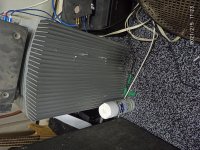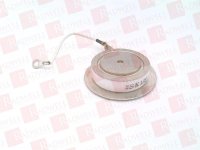It looks like you have the current limit set to 1A on your lab supply (left side). The voltage on the left side is not maximum either. If you series the two channels of the supply I believe you need to set the slave (left side) to maximum and use the right side (master) controls to set your voltage and current.
Your heat sink is also small if you want to run high Iq.
Your heat sink is also small if you want to run high Iq.
To understand what is happening with light bulbs vs resistor, you need to measure voltage drops across the light bulbs and resistor, and put a 0.1R resistor in-line so you can measure the current (or meter in-line).
Maybe your 3x100w lightbulb are limiting the max amp you can get out of this setup. Adding more lightbulb in parallel ?
Hubert
Hubert
According to your numbers your string of light bulbs' resistance is much higher than you thought - 30V/0.5A=60R.
Try less light bulbs - two instead of three (reset bias first).
Try less light bulbs - two instead of three (reset bias first).
Oh! I thought the three lightbulbs should be in parallel to be « equivalent » to a 300w lightbulb.
Last edited:
I haven't built a L'Amp with bulbs. That may be the reason for the high resistance. Parallel makes sense.
Maybe those aren't 100W bulbs, but smaller.
Maybe those aren't 100W bulbs, but smaller.
Last edited:
The bulbs should be in parallel. Are these 120V bulbs (i.e. North America)? 🙂
Measure the resistance of one of those bulbs with a hot filament by hooking it up to your power supply with say 30 volts across it. Read the current drawn for your power supply. R=E/I.
Measure the resistance of one of those bulbs with a hot filament by hooking it up to your power supply with say 30 volts across it. Read the current drawn for your power supply. R=E/I.
the bulbs connected in parallel, like in your videos.The bulbs should be in parallel. Are these 120V bulbs (i.e. North America)?
the bulbs are 220v, perhaps this is my mistake

for 30v on one bulb with hot filament i receive 0.17AMeasure the resistance of one of those bulbs with a hot filament by hooking it up to your power supply with say 30 volts across it. Read the current drawn for your power supply. R=E/I.
maybe i need put more in parallel.
Oh for 220V you need very high power. You need 10 Ohms resistance. For 220V that means you need 4KW bulbs, so I suggest you order 110V ones, you can also find them in Europe, mine I got from France. For this value you would get for 3A about 30V drop, which is about right, you need about half of voltage. OR you could use a nice 195T5 choke from hammond like me 🙂 (and of course reduce voltage)
And again I strongly suggest to use the 0.1-0.25 Ohm resistor on source.
Also remember that for 3A and say 35V on Drain you consume around 100W on your VFET, I think you need bigger sink than that ob your photo.
And again I strongly suggest to use the 0.1-0.25 Ohm resistor on source.
Also remember that for 3A and say 35V on Drain you consume around 100W on your VFET, I think you need bigger sink than that ob your photo.
You may want to watch the power dissipation. This SIT is a 95W part but a 95w rating and remember that 95W is when the actual transistor is at or below 25 C . This is talked about on page 8 of the original article saying that even using a huge heatsink 45W is about as hard as you want to push it. http://blog.audiomaker.tech/pdf/lamp part one.pdf
2SK182ES is 1KW part and I am running it at 500W right now but i have proper cooling. So he can drive it, as long as he has good cooling.
Sorry I thought you were talking about the original amp using a 2sk82 . Where did you find the 2sk182es and how expensive are they ?
from user praas180 or something here, he has a shop in aliexpress. I bought at 80 euros or something but now i see he has them around 100
i do not have 195 right now, but i have big 90v transformer and i order 120v 300w bulbs.you could use a nice 195T5 choke from hammond like me
why? i can calculate the Id from Vds.suggest to use the 0.1-0.25 Ohm resistor on source
woody, thanks for the article
how you do that? how much vcc? and resistance?2SK182ES is 1KW part and I am running it at 500W right now but i have proper cooling. So he can drive it, as long as he has good cooling.
i have 90vdc 2000va and big heatsink from my F5 amplifier
Attachments
Last edited:
You want to use tis resistor so in case bias drops for some reason and Idss runs have time to react and it promotes stability. How do you calculate Id from Vds?
I use custom water cooling loop and i am at +22C delta from ambient.
I don't remember the Vdd because choke has minimal voltage drop and right now I am playing with other IXYS FET. On IXYS I have 49V Vdd and 9A current.
I use custom water cooling loop and i am at +22C delta from ambient.
I don't remember the Vdd because choke has minimal voltage drop and right now I am playing with other IXYS FET. On IXYS I have 49V Vdd and 9A current.
(Vcc-Vds)/RHow do you calculate Id from Vds
Very nice. I was thinking of using a cpu water cooling.I use custom water cooling loop and i am at +22C delta from ambient.
There may be some confusion about this part. It's my understanding that the 2sk182 is the 1000W part, it comes in a round flat package that needs a heatsink on both sides. But the 2sk182es is only a 500w part ! Here is a picture of the 1000w.
Attachments
Your bulbs then are 176 ohms. 3 in parallel is 58 ohms. So, you're current limited (with a 60V supply) to <1A.
In the 2SK82 L'amp schematic you referred to there are two 300W (120V) bulbs in parallel for about 11-13 ohms.
In the 2SK82 L'amp schematic you referred to there are two 300W (120V) bulbs in parallel for about 11-13 ohms.
- Home
- Amplifiers
- Pass Labs
- L'Amp: A simple SIT Amp

